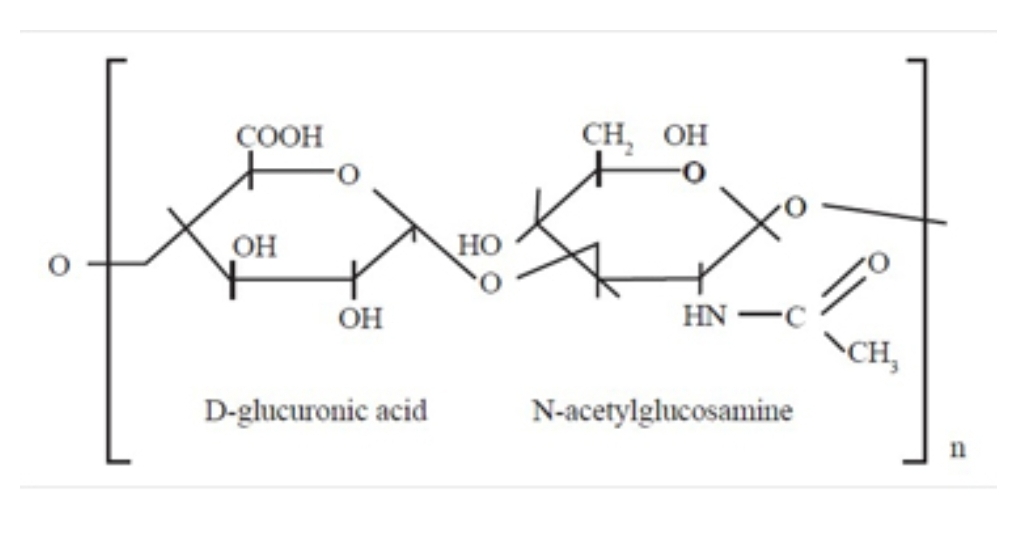OH-기(수산화기) 많아 함습기능이 있는 성분으로 보습제로 사용된다.
수분을 끌어당기는 보습제 성분이며 피부재생을 촉진시키는 성분이다.(1)
진피의 기질과 안구의 초자체, 관절낭에 주로 분포한다.
다른 글라이코스아미노글라이칸이 골지체에서 생성되는것과 달리 세포막단백질에서 생성된다.
D-Glucuronic acid와 N-acetyl-D-glucosamine의 결합이 반복된 구조이다.
Hyaluronic acid, also called hyaluronan, is an anionic, nonsulfated glycosaminoglycan distributed widely throughout connective, epithelial, and neural tissues. It is unique among glycosaminoglycans in that it is nonsulfated, forms in the plasma membrane instead of the Golgi apparatus, and can be very large:
The fourth class of GAG, hyaluronic acid, is not sulfated and is synthesized by three transmembrane synthase proteins HAS1, HAS2, and HAS3.
(참고) https://en.wikipedia.org/wiki/Hyaluronic_acid

오늘날에는 동물 유래 대신 Streptococcus zooepidemicus를 이용한 발효로 얻은 히알루론산을 화장품 원료로 사용하고 있다.
히알루론산은 Glycosaminoglycan (다당류의 일종)으로, N-acetylglucosamine과 glucuronic acid의 2당류가 연결된 구조로 되어 있다.
우리 몸에서 자연스럽게 생성되는 히알루론산은 눈, 눈물, 혈관벽, 관절액 등에 분포하는데, 그 중 약 50%는 피부에 존재하며, 피부에서는 fibroblast, keratinocyte의 세포막에서 합성된다. 히알루론산 1분자는 약 250개의 물 분자를 끌어당기며, 물 분자와 수소결합을 형성하면 부피가 약 1,000배 증가한다고 한다. 또한, 히알루론산 1g은 약 6L의 물을 끌어당길 정도로 물 분자와의 결합력이 강하다. 이러한 특징 때문에, 히알루론산은 피부 조직 내 수분량을 일정하게 유지하도록 역할을 한다. 히알루론산은 분자량에 따라 다른 특성을 나타내는데, 분자량이 클수록 점도가 증가하며 피부에 투과하기 어려워진다. 분자량이 100kDa를 넘어서면, 피부 표피층을 통과되는 데에 한계가 있는 것으로 알려져 있다.
Hyaluronic acid (HA) is a high molecular weight biopolysacharide, discovered in 1934, by Karl Meyer
and his assistant, John Palmer in the vitreous of bovine eyes. Hyaluronic acid is a naturally occurring biopolymer,
which has important biological functions in bacteria and higher animals including humans. It is found in most
connective tissues and is particularly concentrated in synovial fluid, the vitreous fluid of the eye, umbilical cords
and chicken combs. It is naturally synthesized by a class of integral membrane proteins called hyaluronan synthases,
and degraded by a family of enzymes called hyaluronidases.
- 저분자 : 피부장벽을 통과하여 보습효과와 재생효과
- 고분자 : 피부 바깥층에 부드럽고 얇은 막을 형성해 함습효과를 준다.
2. 안티에이징
- 저분자 (약 50kDa) : 피부에 탄력을 주고, 잔주름을 개선하는 효과를 발휘한다.
주기능●
부기능○
(DOSPAW-O)
주효능●
부효능○
보습제
항오일제
항염제
색소억제제
여드름억제제
주름억제제
(표피)
주름억제제
(진피)
항산화제


https://citeseerx.ist.psu.edu/viewdoc/download?doi=10.1.1.513.5936&rep=rep1&type=pdf
Raszeja- Kotelba B., Neumann E., Bowszyc J.: Kwas hialuronowy i skóra.
Polish Journal of Cosmetology 2002, 1, 21-25.
Jaszczuk A., Ostrowska J., Kleszczewska E.: Kwas hialuronowy- jego
właściwości oraz wykorzystanie w kosmetyce i medycynie. Polish
Journal of Cosmetology 2009, 12(3), 185-189.
Jóźwiak- Bębenista M., Nowak J. Z.: Hialuronian: charakterystyka
i praktyczne zastosowanie w medycynie. Farmacja Polska 2010, 66(12),
882-893.
Pavicic T., Gauglitz G.G., Lersch P., Schwach-Abdellaoui K., Malle B.,
Korting H.C., Farwick M.: Efficacy of Cream-Based Novel Formulations of
Hyaluronic Acid of Different Molecular Weights in Anti-Wrinkle Treatment.
Journal of Drugs Dermatology 2011, 10(9), 990-1000.
* 이미지출처 : 이즈앤트리, 닥터오라클
Skin healing
HA plays an important role in the normal epidermis. HA also has crucial functions in the reepithelization process due to several of its properties. These include being an integral part of the extracellular matrix of basal keratinocytes, which are major constituents of the epidermis; its free-radical scavenging function, and its role in keratinocyte proliferation and migration.[18]
In normal skin, HA is found in relatively high concentrations in the basal layer of the epidermis where proliferating keratinocytes are found.[24] CD44 is collocated with HA in the basal layer of epidermis where additionally it has been shown to be preferentially expressed on plasma membrane facing the HA-rich matrix pouches.[18][25] Maintaining the extracellular space and providing an open, as well as hydrated, structure for the passage of nutrients are the main functions of HA in epidermis. A report found HA content increases in the presence of retinoic acid (vitamin A).[24] The proposed effects of retinoic acid against skin photo-damage and photoaging may be correlated, at least in part, with an increase of skin HA content, giving rise to increased tissue hydration. It has been suggested that the free-radical scavenging property of HA contributes to protection against solar radiation, supporting the role of CD44 acting as a HA receptor in the epidermis.[18]
Epidermal HA also functions as a manipulator in the process of keratinocyte proliferation, which is essential in normal epidermal function, as well as during reepithelization in tissue repair. In the wound healing process, HA is expressed in the wound margin, in the connective tissue matrix, and collocating with CD44 expression in migrating keratinocytes.[18][26] Kaya et al. found suppression of CD44 expression by an epidermis-specific antisense transgene resulted in animals with defective HA accumulation in the superficial dermis, accompanied by distinct morphologic alterations of basal keratinocytes and defective keratinocyte proliferation in response to mitogen and growth factors. Decrease in skin elasticity, impaired local inflammatory response, and impaired tissue repair were also observed.[18] Their observations are strongly supportive of the important roles HA and CD44 have in skin physiology and tissue repair.[18]